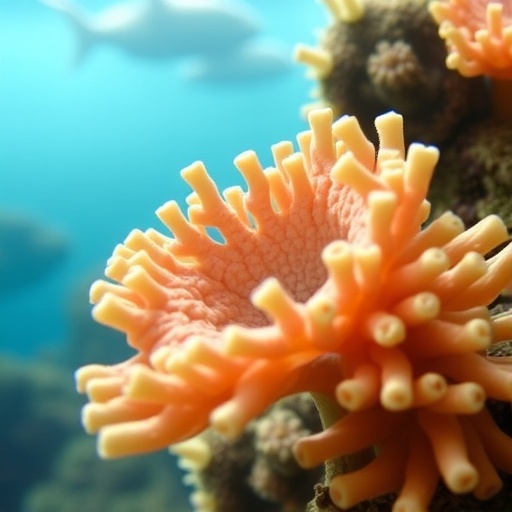In a groundbreaking study, researchers have leveraged cutting-edge genetic technology to analyze a century-old holotype specimen of the Hawaiian pink precious coral, known scientifically as Pleurocorallium secundum. This coral species, which has significant ecological and economic importance, is listed under CITES (Convention on International Trade in Endangered Species). Its usage in jewelry has led to taxonomic uncertainties, which this study aims to clarify. The research represents a pivotal step in understanding the biodiversity and conservation status of not just this coral species, but potentially others in similar circumstances.
The study is spearheaded by a team of scientists including Lendvay, Morf, and Cartier, who have utilized trace DNA analysis to extract genetic material from the aged specimen. Conventional methods of taxonomic classification often rely on morphological characteristics that can change over time due to various environmental factors. This novel approach of using genetic data provides more definitive insights, allowing for a more precise identification of species and potential subspecies, which is crucial given the increasing threats posed by climate change and habitat destruction.
DNA extraction techniques have evolved significantly in recent years, and the team deployed sophisticated protocols to recover the DNA from the degraded holotype. The extraction was followed by advanced sequencing technologies that allowed the researchers to compare genetic sequences with contemporary specimens of the Hawaiian pink precious coral. The results revealed surprising insights that not only confirmed the identity of the coral but also addressed longstanding ambiguities regarding its taxonomic status.
One of the most notable findings of this study was the revelation that Pleurocorallium secundum has genetic markers distinct from other closely related coral species. This reinforces its status as a unique entity within the coral taxonomy, justifying the urgency for conservation measures. Understanding the species’ unique genetic signature could help guide conservation strategies, ensuring that this vulnerable species is effectively monitored and protected in its natural habitat.
Moreover, the implications of this research extend beyond just one species; it sets a precedent for using historical specimens to inform modern conservation efforts. By examining archival specimens that might have been overlooked due to their age, researchers can develop a deeper understanding of the changes in coral populations over time. This is critical, as many coral species are experiencing rapid decline due to factors like ocean acidification and rising sea temperatures.
The genetic data gathered from the study not only addresses taxonomic issues but also enhances our understanding of the evolutionary history of corals in the Pacific. This is important not just for taxonomists but also for ecologists who study the roles of corals within marine ecosystems. The findings suggest that preserving genetic diversity is essential for the resilience of coral communities against changing ocean conditions.
Furthermore, the study raises questions regarding the historical trading practices of corals and their impact on current population dynamics. As the jewelry market has long valued corals for their beauty, the insights gleaned from this research could spark discussions about sustainable practices within the industry. It is imperative that consumers and manufacturers are made aware of the origins and conservation status of coral products.
Ethics play a crucial role in the discussion surrounding coral harvesting and trade. The scientists advocate for a proactive conservation approach that incorporates genetic research into existing policies. By aligning legislative frameworks with scientific data, stakeholders can better protect endangered species, ensuring that cultural practices related to coral use do not compromise their survival.
In conclusion, this study marks a significant advancement in the application of molecular techniques within marine biology and conservation efforts. The successful recovery and analysis of DNA from historical specimens demonstrate the potential for integrating genetics with traditional study methods. As we move forward in the face of global environmental challenges, these innovative approaches will be essential in our efforts to preserve biodiversity and maintain ecological balance.
As the plight of corals gains increased visibility, it is likely that this study will serve as a catalyst for further research into other marine species similarly affected by human activity. Continued investment in genetic research across the natural sciences could yield vital information needed for the comprehensive understanding of ecosystems and the development of effective management strategies. The legacy of historical specimens, combined with modern technological advances, presents a promising avenue for the conservation of our planet’s precious biodiversity.
In summary, the findings of the Lendvay et al. (2025) study on Pleurocorallium secundum underscore the urgent need for an integrated approach to conservation research. It highlights the critical intersection between historical data and contemporary genetic analysis in shaping future policies. By enhancing our understanding of coral taxonomy and evolutionary history, this research not only enriches the scientific community but also serves as a vital resource for conservationists working to safeguard marine life in an increasingly uncertain future.
Subject of Research: Hawaiian pink precious coral (Pleurocorallium secundum)
Article Title: Trace DNA from a century-old holotype specimen resolves taxonomic uncertainties: the case of the Hawaiian pink precious coral (Pleurocorallium secundum), a CITES-listed species used in jewelry.
Article References: Lendvay, B., Morf, N.V., Cartier, L.E. et al. Trace DNA from a century-old holotype specimen resolves taxonomic uncertainties: the case of the Hawaiian pink precious coral (Pleurocorallium secundum), a CITES-listed species used in jewelry. Coral Reefs 44, 1211–1225 (2025). https://doi.org/10.1007/s00338-025-02678-x
Image Credits: AI Generated
DOI: https://doi.org/10.1007/s00338-025-02678-x
Keywords: Coral conservation, DNA analysis, Pleurocorallium secundum, taxonomic classification, CITES, marine biology, genetic diversity, ecological balance, historical specimens, sustainable practices.




